Beginner’s Guide to Boiling Food
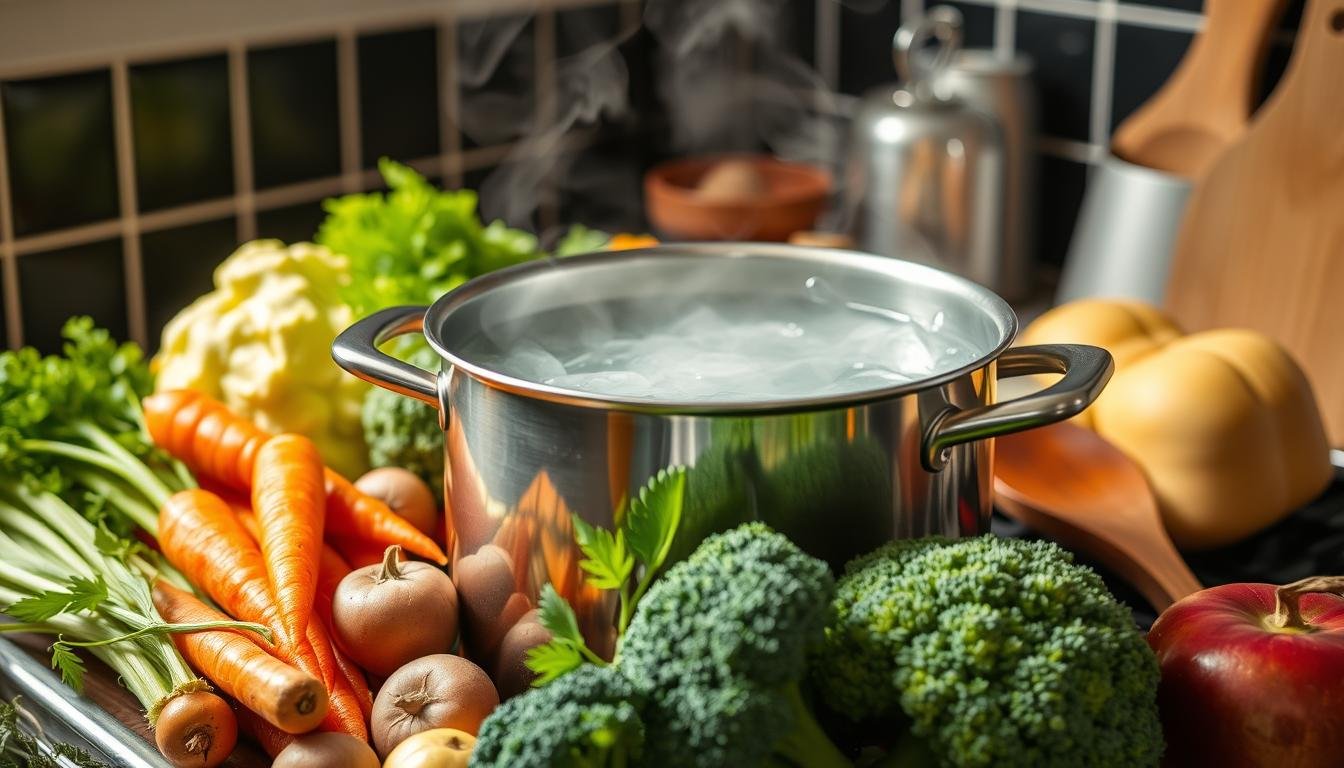
Have you wondered why boiling is so basic but often not well-understood? Boiling food right can really up your cooking game. It matters if you’re boiling an egg or making veggies soft. This guide shows you how to boil food the proper way.
Boiling isn’t just about heat and bubble watching. It applies to veggies, meats, pastas, and grains. Knowing the science and the right techniques can make simple ingredients tasty. This guide is great for beginners. It teaches you boiling basics and builds your confidence in the kitchen.
Key Takeaways
- Boiling is a fundamental cooking method ideal for a wide range of foods.
- Understanding boiling points and temperatures is crucial for achieving perfect results.
- Essential kitchen tools enhance the boiling process significantly.
- Proper preparation and seasoning can elevate the flavor of boiled foods.
- Boiling can be a healthy cooking method that retains nutrients and reduces fat content.
Understanding the Basics of Boiling Food
Boiling is a simple cooking technique. It heats water until it turns into steam. At sea level, water boils at 212°F (100°C). This method is popular for its ease and flexibility.
What is Boiling?
Boiling makes a liquid turn into vapor when heated. It’s popular for cooking eggs, potatoes, and veggies. Keeping the right temperature is key. Water boils at a lower temperature as you go higher above sea level.
Why Boil Food?
Boiling is safer than frying. There’s no hot oil, so less chance of getting burned. It also keeps nutrients in foods like eggs and potatoes. Learning to boil eggs and potatoes well can make meals both tasty and healthy.
Common Foods Suitable for Boiling
Many foods are good for boiling. Each has its own time to cook right. Here’s a table showing how long to boil some foods:
| Food Item | Boiling Time | Notes |
|---|---|---|
| Eggs | 6-12 minutes | Softer yolk with shorter times; hard-boiled at longer times |
| Potatoes | 10-20 minutes | Varies with size and type; cut for shorter times |
| Vegetables | 3-10 minutes | Leafy greens cook faster; roots take longer |
| Pasta | 8-12 minutes | Al dente texture achieved at shorter times |
| Rice | 15-20 minutes | May vary based on rice type and brand |
Mastering boiling basics like eggs and potatoes is key for good cooking. With practice and careful tweaks, you can boil foods to perfection.
Essential Equipment for Boiling
It’s really important to have the right cooking tools. With the best equipment, you can cook better and stay safe in the kitchen.
Types of Pots and Pans
Choosing the right pot or pan matters a lot. 6-quart stock pots and Dutch ovens spread heat well, making your food cook evenly. Cast iron is good because it lasts long and is cheap. But, it needs more care.
Need for a Lid
Lids are super important for boiling. With glass lids, you can see your food cook without letting heat escape. This saves energy. A good lid keeps the temperature steady, so your food comes out just right.

Useful Tools: Thermometers and Timers
Using thermometers and timers makes cooking safer and more exact. An instant-read thermometer keeps you safe from sick-making germs. Timers ensure your food cooks for the right amount of time. So, your dishes will be perfect.
Having these tools will help you boil food like a pro.
Preparing Food for Boiling
Getting ready to boil vegetables is key to great cooking results. You should always clean, cut, and season your food before boiling. Doing this improves flavor and helps you cook meals faster.
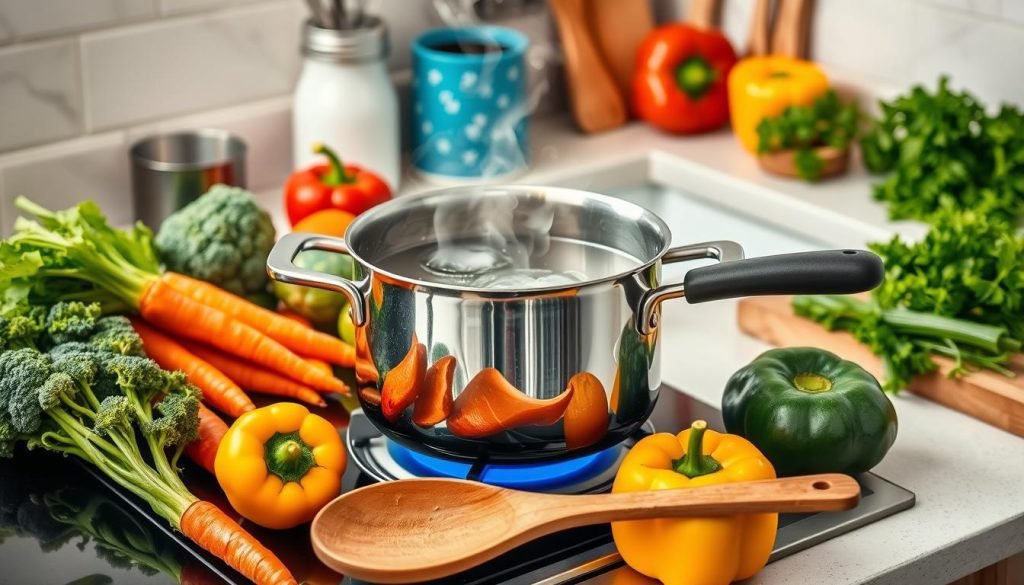
Cleaning and Scrubbing Ingredients
Make sure to clean and scrub your veggies well before boiling. It’s important to remove dirt, pesticides, and germs. A clean kitchen can make your cooking 30% more efficient, studies show.
Cutting Techniques for Even Cooking
When you cut your food, make all the pieces the same size. This helps your food cook evenly. If pieces are the same size, you won’t get some that are too hard or too soft. New cooks might need more time to cook than those with more experience.
Seasoning Before Boiling
Adding spices before boiling makes your food taste better. You should try your food three to five times as you cook. This way, you make sure your meal is flavorful right from the start. This is especially helpful when you’re in a hurry.
The Boiling Process Explained
Getting the perfect boil isn’t just about heat. We’ll show you the steps for safe and efficient cooking.
Step-by-Step Guide to Boiling
Start with the right water amount. A 12-quart pot needs to be ⅔ full with cold water. This prevents overflow when boiling starts.
Put the pot on high heat. Wait for the water to warm up.
- 140–170°F (60–75°C): Quiver – Suitable for poaching delicate items like eggs.
- 170–195°F (75–90°C): Sub-simmer – Best for creating rich stews or braising meat.
- 195–212°F (90–100°C): Simmer – Perfect for steaming vegetables or slowly melting chocolate.
- 212°F (100°C): Full, rolling boil – Necessary for how to boil pasta and ensuring water sterilization.
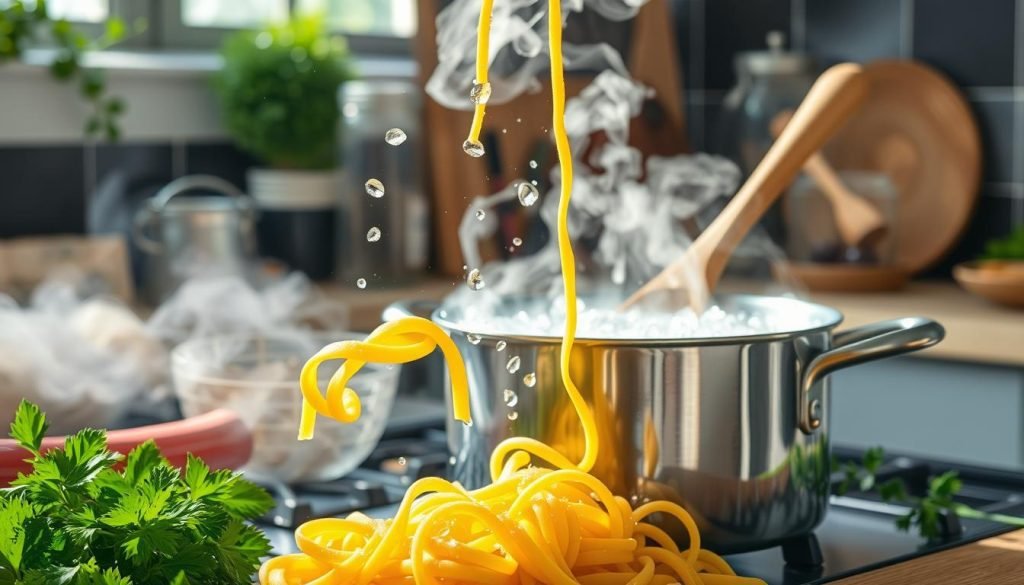
How to Achieve the Perfect Boil
To boil perfectly takes patience and attention. Water boils at 212°F (100°C) in 5-10 minutes on high heat. The time is the same in a kettle.
But, the pot material matters. Aluminum or copper pots heat up quicker than stainless steel ones.
At high altitudes, water boils at lower temperatures. You must boil it longer to kill germs. Boil for at least 3 minutes for safety.
Understanding Boiling Points
The science behind boiling points improves cooking. Knowing the stages helps prepare various recipes. For pasta, a full boil at 212°F (100°C) is crucial.
On the other hand, quiver or sub-simmer stages suit poaching or slow-cooking.
| Temperature (°F) | Stage | Ideal Use |
|---|---|---|
| 140–170°F | Quiver | Poaching Eggs |
| 170–195°F | Sub-simmer | Braising Meat |
| 195–212°F | Simmer | Steaming Vegetables |
| 212°F | Full, rolling boil | How to Boil Pasta |
Boiled water can taste “flat.” To fix this, pour it between two containers before use.
Timing is Key: Cooking Times for Different Foods
Knowing how long to boil food is key to healthy cooking. It helps make your veggies perfect and meats safe to eat. With this guide, you’ll learn the right times for boiling different foods.
Vegetables: Quick and Delicious
Boiling veggies quickly keeps their nutrients. Most vegetables only need a few minutes to soften. For example, green beans and broccoli are done in 3 to 5 minutes. It’s important not to overboil to keep their bright color and crunch.
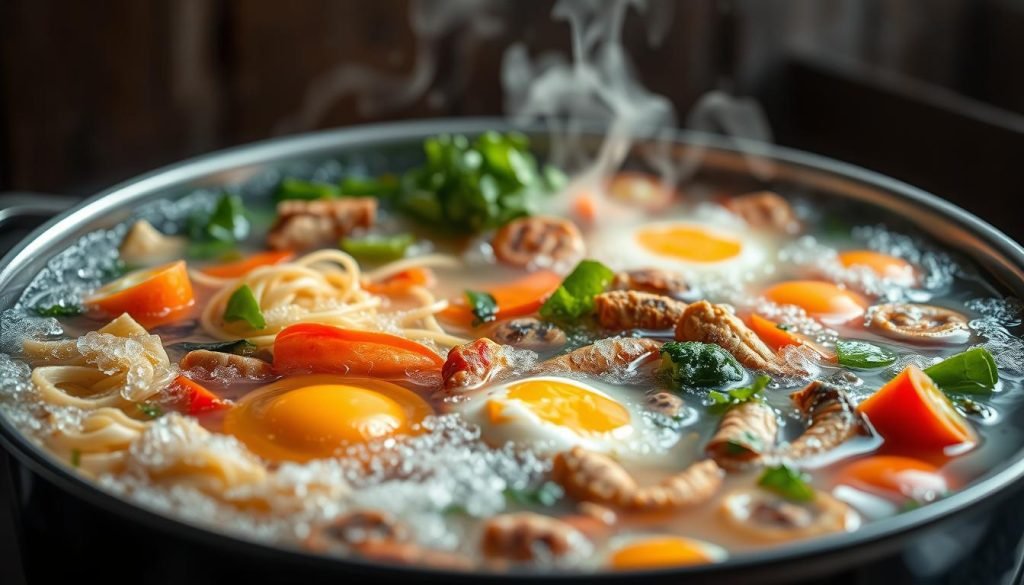
Meats: Safety and Flavor
Boiling meat the right way makes it safe and tasty. Chicken breasts, for example, need 20 to 30 minutes. To boil eggs properly, get the water to 212°F for safety and firmness. Make sure not to crowd the pot for even cooking.
Pastas and Grains: Getting it Right
Cooking pasta and grains well is about nailing the texture. Pasta usually needs 8 to 12 minutes to become al dente. Adding one teaspoon of salt per gallon of water flavors the pasta just right. And remember, a heavy-bottomed pan helps boil evenly.
Getting boiling times right is vital for healthy cooking. It ensures dishes, from veggies to meats and grains, are nutritious and tasty. Proper boiling methods, like knowing how to boil eggs, can improve your cooking a lot.
Common Mistakes in Boiling
Even experts make mistakes when boiling food. Understanding and fixing these errors can make your cooking better. It can take your skills to a new level.
Overcrowding the Pot
Packing too many items in a pot is a mistake. It makes food cook unevenly. Especially for veggies like potatoes. Make sure water can move freely around the food.
Skipping Seasoning
Forgetting to season the water is another error. Seasoning adds a lot of flavor. Putting salt, herbs, and spices in the water makes food taste great.
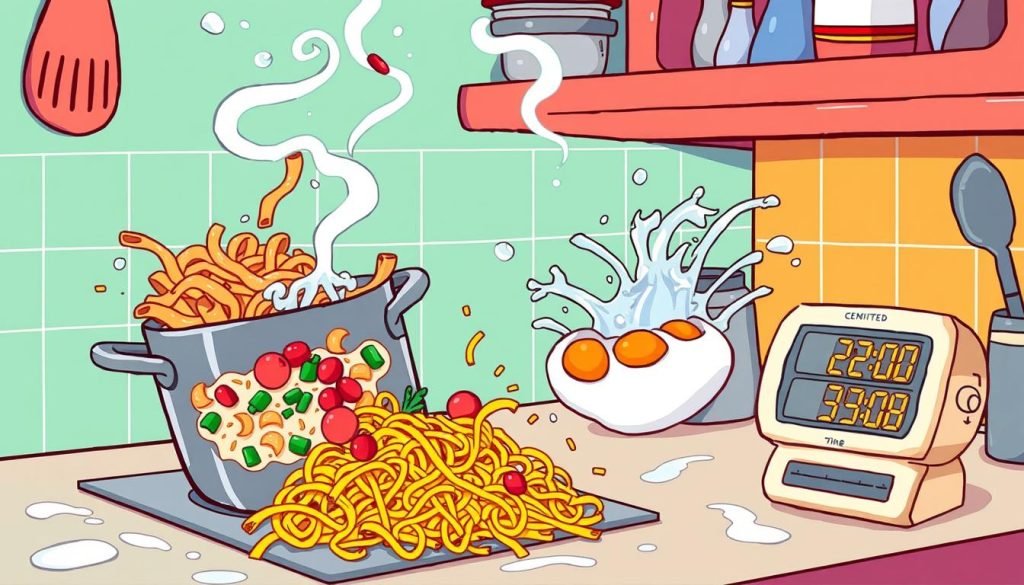
Neglecting Temperature Control
Getting the temperature right is key. Not doing so can ruin food. Keep an eye on the heat to cook food perfectly.
- Overcrowding the Pot: Results in uneven cooking.
- Skipping Seasoning: Affects the flavor profile of the dish.
- Neglecting Temperature Control: Leads to either undercooking or overcooking.
| Boiling Mistake | Consequence | Solution |
|---|---|---|
| Overcrowding | Uneven Cooking | Use a larger pot or boil in batches |
| Skipping Seasoning | Bland Flavor | Add salt, herbs, and spices to the water |
| Poor Temperature Control | Over or Undercooked Food | Monitor heat levels carefully |
By avoiding these mistakes, you can cook better. Paying attention to details means perfect dishes every time.
Enhancing Flavor While Boiling
Boiling may look simple. Yet, using herbs, spices, broths, and acids can upgrade your food’s taste. These boiling tips make meals healthier and more flavorful.
Using Herbs and Spices
Herbs and spices can change how boiled foods taste. Adding bay leaves, rosemary, or thyme works wonders. Cinnamon or star anise adds a warm touch, making dishes special.

For a savory taste, try MSG. It’s full of umami flavor. Start with a mix of 2/3 salt to 1/3 MSG. Later, use half salt, half MSG. This cuts down salt but keeps flavors strong.
Broths vs. Water
Use broths instead of water for more taste. Vegetable or chicken broth makes grains or veggies taste better. It’s a simple, healthy change that adds lots of flavor.
Here’s a guide to boiling liquids:
| Boiling Liquid | Flavor Profile | Common Uses |
|---|---|---|
| Water | Neutral | All-purpose, basic dishes |
| Vegetable Broth | Herbaceous, Savory | Vegetable dishes, grains |
| Chicken Broth | Rich, Meaty | Meats, hearty grains |
| Beef Broth | Deep, Robust | Meats, stews |
Adding Acidic Ingredients
Acidic elements like lemon juice or vinegar add zest. Lemon in boiled asparagus or green beans boosts taste and color. This boiling tip makes dishes look and taste good. It’s great in healthy cooking to keep flavors balanced.
Using these recipe ideas makes boiled food both healthy and tasty. Try herbs, broth, or acidity. Your boiling methods will surely improve.
Cooking in Batches: Efficiency Tips
Cooking in large amounts can change things for those who are busy. It saves time and makes sure you have quick meals ready. It’s about making a lot of food at once.
Meal Prep Through Boiling
Boiling food for meal prep is smart. You can make many meals quickly. Boiling chicken, beef, and veggies lets you create different dishes for the week. The “Rule of 5” means using one ingredient in five meals. It saves time and keeps eating fun.
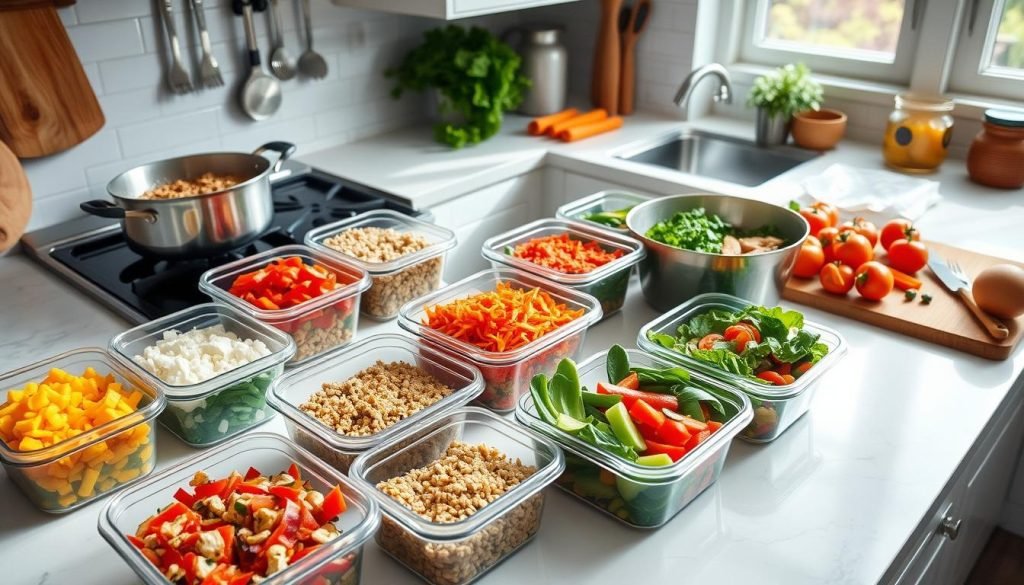
Use foods that are in season. They taste better and are good for the planet. You’re using what’s around you.
Freezing Boiled Foods
Freezing what you cook is smart. Your food stays fresh and you waste less. Use good containers and label them. Then, you can put meals together fast.
For example, cook eggs for 10 minutes and keep them for a week. Freeze chili and soups too. Chili can stay frozen for up to six months. This gives you lots of meal choices.
Reheating Tips
How you warm up food matters. Cover it in the microwave to keep it moist. Stir halfway to heat it evenly. Soups and stews freeze well and reheat in parts. This way, your meals taste good and are healthy.
These hints make meal prep better. You spend less time and stress less on busy nights. Boil lots, freeze right, and reheat with care. You will always have good meals ready.
Health Benefits of Boiling Food
Boiling food is easy and brings many health benefits. It makes food taste great without extra fat. It also keeps the good stuff in your food, making meals healthier.

Nutrient Retention in Boiling
Keeping nutrients in food is a big win for boiling. Sure, boiling can lower vitamin C in green veggies by half. Yet, it makes other good stuff like beta-carotene in carrots more available. Boiling tomatoes boosts lycopene, a strong antioxidant. Using less water and not peeling veggies helps keep more nutrients in your food.
Lowering Fat Content
Boiling lets you cook low-fat meals. You use water, not oil, cutting down calories and bad fats. It’s great for anyone wanting to eat less fat but still enjoy good food. You can boil meats, poultry, and veggies and get delicious, healthy meals.
Reasons to Choose Boiling Over Frying
Choosing boiling over frying has many benefits. Boiled food keeps its moisture and tastes more natural. The American College of Lifestyle Medicine backs boiling for whole food, plant-based diets. Boiling supports low-fat meals because it’s simple and healthy. It’s perfect for veggies, beans, and grains for better health.
| Type of Food | Impact of Boiling | Optimal Cooking Tips |
|---|---|---|
| Spinach | Reduces Vitamin C by 50%+ | Use minimal water, keep the lid on |
| Carrots | Increases Beta-Carotene availability | Boil until tender |
| Tomatoes | Increases Lycopene | Boil with skins on for best results |
| Sweet Potatoes | Reduces Vitamin C by one-third | Keep the skins on, use less water |
Creative Boiling: Beyond the Basics
Boiling can make your cooking exciting. It’s key for basic meals and advanced ones like seafood and legumes. Learn to boil in new ways and your food will amaze everyone.
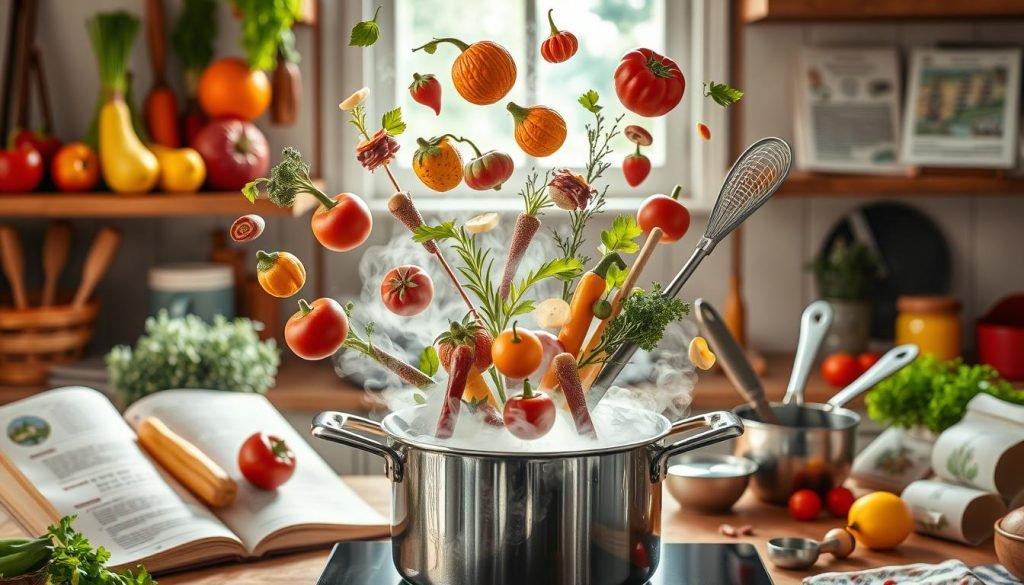
Trying New Foods: Seafood and Legumes
Adding seafood and legumes changes your cooking game. Tender shrimp and mussels from boiling are superb. Legume dishes, like chickpea stews, add health and taste.
Making Soups and Stews
Soups and stews let you play with boiling. Use different ingredients for exciting pots of food. Classic or hearty, mix broths, herbs, and textures for comfort.
Some stews mix boiling with braising. This mix brings out the best in your meals.
Combining Flavors for Unique Dishes
Boiling blends flavors into special meals. Add herbs and spices for incredible tastes. Lemongrass and ginger make seafood sing, while cumin and coriander enrich legumes.
Start simple, try things out, and learn from errors. Your cooking skills will grow, maybe by 50% in half a year. Boiling opens up new cooking adventures. Master it and wow with your dishes.
Troubleshooting Common Boiling Issues
Boiling can be tough, especially for beginners. Learning to fix common problems helps. Mastering overboiling, flavor fixes, and the right texture is key.
When Things Overboil
Overboiling is a typical issue. If your pot’s overflowing, lower the heat right away. It’s usually because it’s too hot. To avoid mess and flavor loss, watch your pot and stir often.
Fixing Flavor Problems
It’s common to mess up the taste when boiling. If it’s bland or too strong, tweak the seasonings. Adding herbs, spices, or broth can add more flavor. Gradually adding seasonings is the best approach. Taste often to get it just right.
Texture Troubles: Overcooked vs. Undercooked
Getting the texture right is key. If it’s overcooked, food turns mushy. If it’s undercooked, it could be hard. Timing is crucial. Use a timer and follow the boiling times.
For example, veggies boil faster than meats or grains. If it’s not done, boil a bit more, but watch it closely.
These tips will help you fix your boiling mistakes. They’ll lead to tasty and perfectly cooked meals.
Final Thoughts: Mastering Boiling
Learning how to boil properly is important in cooking. To get better, you need to practice a lot and try new things. Even though many people prefer ready-made food, learning basic skills like boiling is getting popular again, thanks to COVID-19.
Practice Makes Perfect
To get better at boiling, practice regularly. Set aside 60 to 90 minutes for cooking and cleaning. This helps you not rush and do well. This fits well with younger cooks’ liking for simple recipes that still need a good boil.
Keep Exploring and Experimenting
Trying new things is important in cooking. Change up ingredients, use different spices, and adjust boil times for various foods. This not only betters your skills but also helps you find new tastes. It’s key, as many beginner cooks want meals that are both quick and full of flavor.
Connecting with Cooking Communities
Being part of cooking groups is very helpful. You can share experiences, get advice, and find trustworthy recipes. This makes sure you’re learning the right things and not getting tricked by wrong recipes online. Connecting with others who love cooking improves your skills and enjoyment in the kitchen.